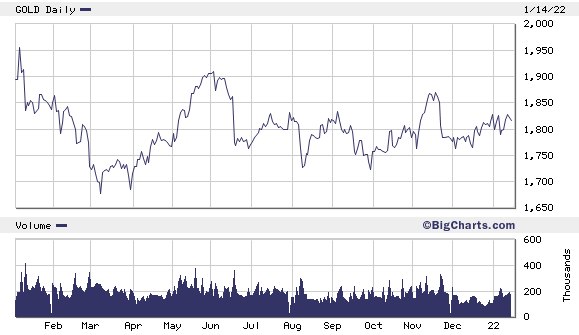| 2021 was not a great year for gold bugs.
Gold prices fell by more than 7% last year despite facing a sharp rise in inflation, refreshed fears over coronavirus variants, continued political and social instability, increased debt levels, and a general decline of trust in governments worldwide.
Gold Prices — One Year

No, it was not a great year for gold bugs.
But it wasn’t a terrible year for the yellow metal either.
To be fair, gold started 2021 pretty strong. Prices reached an all-time record high in August 2020 — topping an intraday high of over $2,050 an ounce — and closed the 2020 year on a strong note.
A look at a longer-term chart of gold shows us prices were mostly flat for 2021.
Gold Prices — 2015 to Present

So 2021 wasn’t the best year for gold bugs. But it wasn’t the worst. 2021 was mostly a neutral year for gold.
Regardless of gold’s lukewarm performance, however, the demand for physical gold bullion last year skyrocketed.
|
| Pfizer CEO Shocks the World With Confession
This is perhaps the most disturbing piece of news I’ve seen come out of this pandemic yet…
Pfizer’s CEO just admitted that if you received two doses of his company’s vaccine last year, your protection is already GONE.
What an absolute farce. It’s become very obvious that the real beneficiaries are the vaccine makers themselves.
So what do we do now? Where does that leave the world?
Well, I’ve just found a company with a solution to COVID that could be better than the vaccine… one that has nothing to do with needles.
It’s actually a “COVID-killing” nasal spray.

And it has the potential to end COVID once and for all.
This could hand you the biggest biotech windfall of the decade…
So I urge you to act while there’s still time.
Learn more about this “COVID-killing” nasal spray here. |
Physical Gold Bullion Demand Jumped Last Year
According to the latest data from the U.S. Mint, sales of its gold bullion increased by over 67% to 1.44 million ounces last year — reported to be the highest levels since 2009.
 Source: U.S. Mint Source: U.S. Mint
Meanwhile, sales of U.S. silver bullion also saw increases. The Mint sold 12.2 million ounces of silver in 2021, an increase of 51% compared with the previous year.
Part of the increase in sales can be attributed to the Mint’s redesign of the American Eagle.
Last year, the U.S. Mint changed the reserve design of the American Eagle to coincide with the 35th anniversary of the coin series.
 Source: U.S. Mint Source: U.S. Mint
This redesign was heavily marketed and likely contributed to spurring sales. But the redesign didn’t completely drive bullion sales.
On the other side of the world, Australia’s Perth Mint also saw record sales last year.
According to data released two weeks ago, the Perth Mint sold over a million ounces of gold in 2021 — a 35% increase compared with the previous year and the Mint’s highest sales numbers in a decade.
Looking Ahead to 2022
An increase in holdings of physical gold bullion is a good setup for a rally in prices. That’s partly because of gold’s liquidity.
One thing about physical bullion that people tend to overvalue is its liquidity. It’s true that gold and silver bullion are more liquid than ever. With the advent of the internet, you can pretty much find a place to sell your gold or silver bullion 24/7. Nevertheless, physical bullion is much less liquid than stocks or ETFs.
The absolute fastest way to sell physical bullion is through a cash/check transaction or wire transfer. However, both require way more time than selling a stock online.
A cash/check transaction can take several days, especially with large transactions. Bullion dealers don’t keep large piles of cash in their back rooms for obvious reasons. If you walked into any legitimate bullion shop in America and wanted to sell $50,000 worth of gold, not only would you be required to fill out IRS paperwork, but you’re going to get a check — not cash. Selling a gold ETF takes seconds.
Selling physical bullion via a wire transfer is a little easier and faster. But you still have to mail the sold bullion to the buyer, which always means you need to go to the post office. Selling a gold stock can be almost instant.
|
| New Robot Has Tech Execs Scrambling
You might not believe this is even real, but I assure you this video has been left unedited.
Nearly every tech company in the world is scrambling to get its hands on this tech.
And investors are set to profit handsomely.

Get the details on our Top 3 Stocks Picks here. |
Point is, holding physical bullion typically slows the selling process for the investor. And a market with a lot of investors holding an asset that’s a bit harder to sell is more protected from rapid sell-offs than other assets.
The truth is only a very small fraction of the population owns any kind of significant bullion holding.
Everyone has gold and silver in their house somewhere, but most of the time any valuable precious metals are in jewelry. And jewelry is typically not an investment-grade bullion asset, which has standard purities and weights for easy trading.
Moreover, even when a household does have investment-grade bullion, it’s typically in very small amounts. A lot of people have American Silver Eagles, given to them by their uncles or grandfathers, that might be worth a few hundred dollars. But investors with sizable stashes of investment-grade bullion are relatively rare.
There is really no way to know for sure, but I have heard it estimated that less than 2% of the U.S. population holds any significant amount of physical gold or silver bullion.
So in the gold market, a little physical metal-buying goes a long way. If the estimate that less than 2% of the U.S. population owns any significant amount of bullion can be believed (and I do think it’s at least close to accurate), just a small increase in the number of new bullion buyers can have a significant effect on the market.
Until next time,

Luke Burgess |
 Gold’s Not Dead
Gold’s Not Dead
 Gold’s Not Dead
Gold’s Not Dead